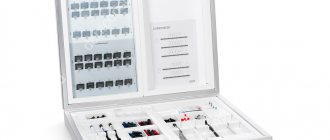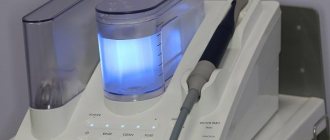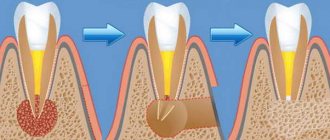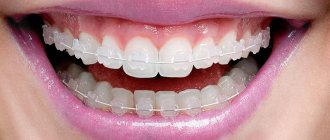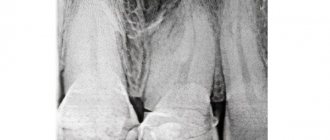HomePeriodontologyTreatment of periodontal disease with SIEMENS laser
The main reason patients visit a dental clinic is severe pain. Different diseases of the teeth and gums may have similar symptoms, and only a specialist can make an accurate diagnosis. The most common is periodontal disease. If treatment is not started in a timely manner, the development of the disease leads to inevitable tooth loss. Therefore, it is necessary to contact a dentist when the first symptoms of the disease occur.
Causes of periodontal disease development
The appearance of periodontal disease occurs for various reasons. As a result of examining more than 750 thousand patients, US scientists found that the disease primarily develops due to bacterial plaque on the teeth and a decrease in the body’s immune defense. It has been established that microorganisms that live in deposits and plaque on teeth are directly related to the development of the disease. It is the waste products of these microbes that have a negative effect on the gums and dental tissue, causing their destruction.
First, a person notices bleeding gums while brushing their teeth, which can also be accompanied by pain. Therefore, the process of oral and dental hygiene becomes more careful and of lower quality. As a result, plaque only increases, turning into tartar. At the same time, the environment for the development of microorganisms becomes especially beneficial.
During this time, inflammation and periodontal condition only worsens. Moreover, the negative process affects the activity of microvessels, which reduces nutrition, accelerating destruction. After this, the inflammatory phenomenon affects the bone tissue.
Another reason for the development of periodontal disease lies in the disruption of immune defense. The human body can be subject to disruptions due to stressful situations, trauma, and hormonal problems. As a result, immune cells perceive periodontal tissues as foreign and attack them. Such exposure causes aseptic inflammation of the gum tissue with subsequent death. Then the negative process moves to the bone tissue. The third stage of the disease is characterized by loosening and loss of teeth.
The following factors can aggravate the course of the disease: diabetes, smoking, gastrointestinal disorders, stress, hormonal imbalances, advanced caries, poor dentures and malocclusion.
Indications for laser treatment of periodontitis
Many patients with gum health problems are willing to undergo laser periodontitis treatment. Prices
acceptable for such a procedure. In addition, this method of treatment is painless and low-traumatic, and does not require long-term rehabilitation after the procedure. Let's consider for what signs a doctor may recommend laser treatment.
Indications:
- bleeding gums;
- discoloration of gum tissue;
- dental plaque, tartar;
- purulent discharge from under the gums;
- separation of soft tissues from the crown of the teeth;
- exposure of the tooth root;
- loosening of teeth;
- the appearance of putrid odor from the mouth.
The effectiveness of laser treatment is observed at almost any stage of the disease. But, there are some contraindications for which this treatment method cannot be used.
Laser treatment of periodontitis is not performed on patients:
- those suffering from severe diabetes mellitus;
- for autoimmune disorders;
- for oncological diseases;
- if there are serious diseases of the cardiovascular system;
- endocrine pathologies;
- tuberculosis;
- poor blood clotting;
- after a heart attack and surgery.
If the patient has a history of diseases included in the list of contraindications to laser treatment, the doctor will select an alternative method to combat the inflammatory process in periodontal tissues.
Periodontal disease - symptoms and signs
The first signs of the development of the disease include:
- Itching and discomfort in the gums;
- Bleeding while brushing teeth;
- Swelling and change in the shape of the gums;
- Unpleasant odor;
- Specific salty taste in the mouth.
If therapy is not started in a timely manner, purulent lesions will soon form in the gums. Pain increases, its color, shape and structure change.
In such cases, enlarged lymph nodes cannot be ruled out. And x-rays will show pathological changes in bone tissue with inflammatory foci and destruction of interdental septa.
Periodontal disease - how is it diagnosed?
Correct treatment of periodontal disease is possible only after a thorough diagnosis. However, one examination by a dentist will not be enough. You should undergo tests using modern equipment and drugs.
In the dental practice of the Bionic Dentis clinic, the German protocol is used to examine patients. This allows you to conduct a full examination and accurately make a diagnosis.
This examination includes:
- Inspection using an optical system that allows you to significantly enlarge the inspected surface and not miss even the slightest damage;
- Testing for hidden plaque on teeth. To do this, a special preparation is applied, which indicates the places where harmful microbes accumulate;
- Determination of inflammation using a marker drug that can indicate lesions;
- Bana testing, which helps identify microorganisms that cause the development of the disease. Thanks to this technique, a competent selection of antibacterial therapy occurs. Specialists from the Bionic Dentis clinic were among the first to conduct bana testing in Russia;
- An X-ray and orthopantomographic examination procedure that allows you to assess the condition of all dental tissues that are not visible during a simple examination. This helps prevent and prevent further development of inflammation.
After reviewing the results of a complete diagnosis of the patient, specialists at the Bionic Dentis clinic draw up a treatment plan. This approach allows us to completely cure 99% of patients suffering from periodontal disease who contact us.
What can a laser do?
The range of capabilities of this equipment is very wide, which is why it is used in a variety of cases, for example:
- Treatment of caries
- Teeth whitening
- Gum surgery
- Treatment of root canals and cysts
- Plastic surgery of soft tissues
- Treatment of inflammatory diseases of soft tissues and periodontitis
- When installing a braces system
- When implanting implants and treating complications after operations.
Laser technologies help patients forget about the fear of visiting the dentist and receive treatment in absolute comfort! This irradiation can also:
- Improve microcirculation
- Relieve inflammation
- Improve healing
- Increase local immunity
Stages of a unique technique:
- 1. Begin therapy with ultrasonic cleansing of the entire tooth and its root. This removes plaque and stones. The use of ultrasound allows you to thoroughly clean even the most difficult to reach areas without pain or injury to the enamel. Specialists at the Bionic Dentis clinic perform this procedure using a special Sirosonic Sirona Siemens ultrasound device, manufactured in Germany. In this case, the level of processing is selected individually, which significantly increases work efficiency.
- 2. The second stage includes the removal of pigmented plaque and microscopic deposits located in hard-to-reach places. For this, the Air Flow technique is used. The method is implemented using a Prophyflex dental handpiece from the German company Kavo, from which mixed air and abrasive are released under high pressure. This mixture allows you to effectively eliminate the remains of infection and other contaminants. The peculiarity of the method is the use of calcium carbonate, which has a gentle effect on the gums and root system of the tooth. In combination of this drug with the Prophyflex device from Kavo, the procedure is performed with the utmost quality.
- 3. At the third stage, laser sterilization of the root pockets and gum edges is performed. Doctors at Bionic Dentis use the Sirolaser Sirona Siemens dental laser (Germany). The laser tip is inserted into the gum pockets, which leads to the complete destruction of pathogenic bacteria that cause the disease. The unique laser setting allows not to damage the gums, but to have a detrimental effect on microbes.
- 4. The fourth stage includes drug therapy using calcium copper hydroxide. The medicine is placed in the gum pockets, leaving it there for a long time. The drug relieves inflammation and sterilizes periodontal pockets in which the pathological process has begun. Our specialists use a patented original drug from the German company Humanchemie. This manufacturer is also the developer of this medicine.
- 5. At the fifth stage, the metabolism in the gingival tissues is corrected. For this purpose, the active tissue regeneration complex prf is used. The patient first donates blood from a vein, which is subjected to special treatment. This makes it possible to isolate specific prf proteins. It is these substances that can trigger tissue restoration and healing processes in the human body. Due to the fact that the proteins are obtained from the blood of a specific patient, there are no side effects or allergic manifestations. The process of obtaining active proteins for regeneration is an important and responsible procedure, which is performed under strictly sterile conditions. For this purpose, Bionic Dentis specialists use a method invented by scientists from the Munich and Charité clinics (Germany).
Advantages
Treatment of purulent inflammation of the gums with a laser has the following advantages:
- Painless. During treatment, the patient does not feel discomfort or pain, since there is no direct contact with the tissues.
- Antiseptic effect. Light treatment destroys pathogenic bacteria on the gum surface, which eliminates the development of an infectious lesion.
- Non-contact technique. The principle of using laser processing eliminates the need for contact between the instrument and tissue. This reduces the risk of injury and ensures safety during therapy. Also, the non-contact method protects the wound from infection and makes the incision bloodless and clean.
- Absence of such effects and complications. The technology provides a targeted effect on the affected area without affecting the surrounding tissue. The peculiarity of the treatment also eliminates the occurrence of complications and the development of inflammatory processes.
- The risks of relapse are minimized. The rehabilitation period is reduced, the patient does not feel discomfort or pain after the treatment. Tissues are restored quickly.
What antibiotics are prescribed for the treatment of periodontal disease?
When contacting a specialist in a severe stage of periodontal disease, you cannot do without prescribing antibacterial therapy.
Antibiotics must be prescribed if:
- Pus was found in periodontal pockets;
- There are putrefactive-necrotic inflammations of the gingival tissue;
- The bone tissue is affected by purulent foci.
Antibacterial agents with a wide spectrum of action are used in dental practice. They show rapid activity in pathologies of any complexity, causing the death of harmful microorganisms.
The Bana test, which is used at the Bionic Dentis clinic in diagnosing periodontal disease, allows you to select effective drugs taking into account a specific clinical case.
Laser sterilization
Where teeth are located, the gums form a periodontal pocket. In a healthy person it has a shallow depth. In the absence of normal oral hygiene, plaque accumulates on the surface of the teeth. Gradually it mineralizes, turns into stone and spreads under the gum. As tartar grows, it increases the depth of the gum pocket. Inflammation develops. The tissues that hold the tooth begin to break down. Mobility of the tooth appears, and in advanced cases it falls out.
One of the tasks that the periodontist must solve during treatment is sterilization of the periodontal pocket and elimination of pathogenic microflora in it.
For this purpose, the ARDC clinic uses a laser. During diagnosis, the periodontist determines which gum tissues are affected by the inflammatory process, the degree of their damage and other features of the clinical picture. Depending on them, he selects the type of laser:
- Carbon dioxide and diode lasers. Used when inflammation affects only soft tissues. They are effective in the early stages of periodontitis.
- Erbium laser. It is used if inflammation has spread to hard tissue. Treatment with an erbium laser is indicated in the later stages of periodontitis, with an aggressive course of the disease.
During the procedure, the doctor acts with a laser beam on the surface of the periodontal pocket. The laser evaporates the affected cells and kills pathogens. In this case, the beam does not injure the treated area, since the coagulation process occurs. A protective photocoagulation film is formed on the surface of the tissue.
Dentistry for those who love to smile
+7
Make an appointment
The process of treating periodontal disease at home includes:
- Mandatory brushing of teeth after each meal with Parodontax medicinal periodontal paste, widely used at any stage. The best tool for cleaning teeth is the Sensodyne medium toothbrush, which has medium hardness. You should also use a thin and flexible dental brush for the morning and evening procedures;
- Daily use in the evenings of an oral irrigator - a special device that cleanses the teeth and massages the gums using a stream of water and air. This improves blood flow in the vessels, has a positive effect on the condition of the periodontium, and reduces inflammation of the gingival tissue. The best irrigator is Braun Oral-B.
- Rinse your mouth thoroughly after eating using a special product;
- Lubricating the gums with Asepta gum balm, which eliminates pain and inflammation, exhibiting a disinfectant and healing effect.
- These products can be used as prescribed by a specialist, after the procedure for treating periodontal disease with ultrasound and active prf regeneration proteins has been carried out.
An integrated approach in the form of a clinical and home therapeutic course will ensure a positive result and maximum effect.
Periodontal disease treatment cost
To determine the cost of the entire course, it is important to know what mandatory procedures it includes:
- Diagnosis of gum condition, selection of medications and products for home use;
- Deep laser cleaning of gums;
- Course therapy with laser and injections of active regeneration proteins prf.
If necessary, additional measures are prescribed:
- Splinting of mobile teeth using fiberglass;
- Making a relaxation mouthguard.
As a result, the average cost of mandatory procedures that are included in the course of treatment of periodontal disease with laser and prf is 140,000 rubles.
The price of splinting teeth on one jaw using fiberglass is 35,000 rubles.
Production of a relaxation mouth guard – 20,000 rubles.
Why is periodontal disease treatment expensive?
Course treatment of periodontal disease is a high-tech process, which is performed by highly qualified specialists. In their work, doctors use expensive modern equipment and original medications produced in Germany.
The Bionic Dentis dental clinic has a full arsenal of high-tech equipment: a laser, a dental orthopantomograph, a blood processing system for isolating active prf regeneration proteins, the cost of which is several million rubles.
At the Bionic Dentis clinic, patients are guaranteed the authenticity of all equipment and medications. This is confirmed by certificates of conformity and registration certificates of Roszdravnadzor.
To provide affordable treatment to a wide range of patients, the Bionic Dentis clinic offers interest-free installments for a year.
The down payment is 30% of the total cost of treatment. The remaining amount is distributed evenly over 12 months.
Russian citizens aged 18-70 years can apply for an installment plan in just 15 minutes.
Contraindications
Laser treatment is safe and has virtually no contraindications. The procedure cannot be performed in the following cases:
- The presence of severe forms of heart and vascular diseases.
- Patients with open form of tuberculosis.
- For insulin-dependent type of diabetes mellitus.
Our clinic uses the latest generation lasers. We successfully use them in the treatment of periodontal disease and periodontitis. Since laser treatment produces quick results in the early stages of the disease, this allows us to reduce the final cost of gum treatment.
How to find a specialist to treat periodontal disease?
Carrying out full treatment of periodontal disease requires modern equipment and imported drugs. But the main thing is a specialist with the necessary knowledge and experience. Therefore, when choosing a periodontist, it is important that he has a certificate confirming the specialist’s qualifications. Also, the doctor must be trained in the treatment of periodontal disease using a laser and active prf regeneration proteins.
The specialists of the Bionic Dentis clinic are highly qualified and have specialized medical education. They have certificates confirming that they have completed training with German specialists.
The average experience of our periodontists is 10 years. They regularly participate in international conferences on clinical periodontology.
When choosing a periodontist, an important point is confidential communication with the patient. If a specialist explains the main features of the procedures, talks about the effects of the drugs used, possible side effects, contraindications and other aspects, then you have found your doctor!
Werner Elena Vladimirovna
Dentist periodontist
More details


